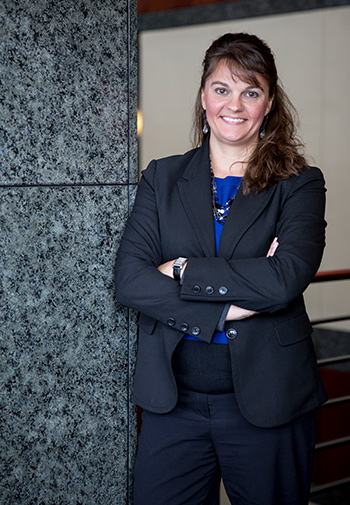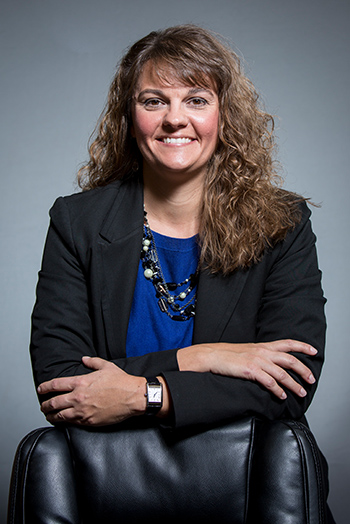Managing 403(b) accounts: Going beyond suitability standards
Managing 403(b) accounts: Going beyond suitability standards

Katie Williams, AIF, CRPC, CRPS, CFP • Minneapolis, MN
Classic Financial Services • LPL Financial
Read full biography below
The growing trend that allows participants more say in their 403(b) accounts is opening the door for
advisors to use third-party active money managers for risk mitigation and asset growth.
Proactive Advisor Magazine: Katie, what attributes have made your practice successful?
 I have at least four distinct constituencies: the providers or vendors of 403(b) plans, consultants when they are part of the picture, school system administrators, and the plan participants themselves. It is very important to make sure the needs of each are being met professionally and with expert guidance. But it is equally important to understand where their needs intersect and to be able to facilitate a productive working environment and process that benefits all parties.
I have at least four distinct constituencies: the providers or vendors of 403(b) plans, consultants when they are part of the picture, school system administrators, and the plan participants themselves. It is very important to make sure the needs of each are being met professionally and with expert guidance. But it is equally important to understand where their needs intersect and to be able to facilitate a productive working environment and process that benefits all parties.
In my credentialed capacity, I am committed to a high standard of fiduciary care and guidance. This includes regularly scheduled follow-up meetings with plan administrators, ongoing investment monitoring and fund benchmarking, and group and one-on-one participant education and guidance. I think what really sets my practice apart is that I do not just work in a sales capacity—I am an active partner and plan consultant.
What is your role with the participants?
I want to provide objective, unbiased advice from a fiduciary perspective that seeks to place client interests first at all times. My clients come to recognize the important role that professional guidance and a comprehensive financial strategy play in the pursuit of their financial goals. As I serve clients in this fiduciary capacity, I need to act in a client’s best interests, not simply meet suitability standards where investment decisions are concerned. I want to provide all of my clients with the information and guidance required to help them make the most appropriate financial decisions for their needs and circumstances.
“The protection of capital is just as important as having the opportunity to see assets grow over time.”
How does active investment management fit into your practice?
There is a growing trend for plans to allow participants to have more of a self-directed option where I can help clients actively manage their 403(b) accounts, but that is still relatively limited within the school districts I work with.
My experience with third-party active money managers is much more concentrated with my personal financial-planning clients, who in many cases have come to me with rollover funds or inheritances, or other nonqualified money they have been able to save over the years. In many cases, they may be clients who first met me through the school environment.
Describe active money management.
 There are two important distinctions about active management I explain to clients versus a passive allocation approach. First of all is the element of providing risk-management tools within a portfolio that can offer some level of downside market protection during trending market corrections. Second is the ability to more proactively rotate among asset classes, exposure levels, and strategies that are dependent upon current market conditions, whether they are bullish or bearish.
There are two important distinctions about active management I explain to clients versus a passive allocation approach. First of all is the element of providing risk-management tools within a portfolio that can offer some level of downside market protection during trending market corrections. Second is the ability to more proactively rotate among asset classes, exposure levels, and strategies that are dependent upon current market conditions, whether they are bullish or bearish.
The active managers I use look at the market environment on a continual basis and implement changes to portfolios according to their models, as required, as frequently as bi-weekly. I explain to clients how this makes so much more sense than just passively accepting whatever the market throws their way. I also tell them that these active managers are not restrained by prospectuses or fund restrictions telling them that they need to keep exposure to a certain asset class, no matter what is happening to that asset class. Some managers even have the ability to employ an inverse position to the market, taking advantage of declining market conditions when the trend is pointing that way. This is where one of the real differentiations of the active approach can become apparent.
How does active management fit with your typical client profile?
Of course, no client is typical, and everyone has their own specific financial-planning and investment needs. And each client is very different in their attitude toward risk. But that is one of the things I find most advantageous to the third-party managers that I use. Their approach to active management provides a very broad umbrella of strategies that can accommodate investors of all types, from the most risk-averse to those leaning toward the aggressive side.
If I were forced to generalize, I would say my client base is generally not high-net-worth. They are more your average hard-working, middle-class types. Many of them are teachers and most are in dual-income households—sometimes even two teachers within the same household. Typically, teaching professionals may have a very nice pension plan in addition to the 403(b) option, but even then they are not individuals who will have an overwhelming amount of money from all sources for their retirement.
I take the responsibility of helping them to manage their investments very seriously, and the protection of capital is just as important as having the opportunity to see their assets grow over time. Active money management is one tool in my practice’s arsenal that fits these criteria very well.
 In 1987, Katie Williams’ father founded the 403(b) division of National Benefits, a well-regarded 457 and 403(b) consulting service and benefits communication firm. Over the course of two decades, Katie had the opportunity to learn and further grow the business, working alongside and learning from both of her parents. She later established Classic Financial Services to continue the family legacy of providing 403(b) plan consulting and communications services to a diverse mix of school districts and not-for-profit organizations, and their respective plan participants.
In 1987, Katie Williams’ father founded the 403(b) division of National Benefits, a well-regarded 457 and 403(b) consulting service and benefits communication firm. Over the course of two decades, Katie had the opportunity to learn and further grow the business, working alongside and learning from both of her parents. She later established Classic Financial Services to continue the family legacy of providing 403(b) plan consulting and communications services to a diverse mix of school districts and not-for-profit organizations, and their respective plan participants.
As a retirement-planning specialist, Katie has spent more than 15 years serving the needs of 403(b) plan sponsors and their participants. She brings extensive experience working with over 100 plans and school districts. Her knowledge and experience as an Accredited Investment Fiduciary enable her to assist school districts in plan design and fiduciary guidance, educate plan participants in aligning their investment allocations with their individual goals and values, and facilitate retirement plan rollovers. Based near Minneapolis, she is widely known among school districts throughout Minnesota as a strong educator and trusted advisor.
Disclosure: Katie Williams offer securities and advisory services through LPL Financial, a registered investment advisor. Member FINRA/SIPC. No strategy assures success or guarantees against loss. Investing in securities is subject to risk and may involve loss of principal. Active money management may involve more frequent buying and selling of assets and will tend to general higher transaction costs. Investors should consider the tax consequences of moving positions more frequently. Asset allocation does not ensure a profit or protect against a loss. Bonds are subject to market and interest rate risk if sold prior to maturity. Bond values will decline as interest rates rise and bonds are subject to availability and change in price. Alternative investments and leveraged strategies may not be suitable for all investors and should be considered as an investment for the risk capital portion of the investor’s portfolio. The strategies employed in the management of alternative investments and leveraged investments may accelerate the velocity of potential losses.
Photography by Ackerman & Gruber

